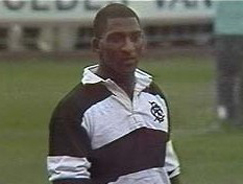Sporting greats
Errol Tobias: a black Bok in a white team
Opposition to Tobias' inclusion
It wasn't an easy break to deal with. There was opposition to Tobias' inclusion from both black and white communities. Some within his own community in Caledon felt he should not play as long as apartheid policies existed, while many white people who supported apartheid wanted Tobias excluded. Remembering that time, Tobias said: "We had no say in politics. We didn't even have a vote, so all I knew at that stage was to play rugby. My goal was to show the country and the rest of the world that we had black players who were equally as good, if not better, than the whites, and that if you are good enough you should play." Tobias turned out in both Tests against the touring Irish, with South Africa winning 23-15 at Newlands and 12-10 in Durban. In that same year, Tobias was selected for the Springbok tour of New Zealand, but found himself out of favour and restricted to appearances in the midweek side.England thrashed
He had to wait some time for his next Test cap, which came in 1984 against England in South Africa. With Tobias pulling the strings at flyhalf, the Springboks handed the English two big losses, 33-15 in Port Elizabeth and 35-9 in Johannesburg. Later that year Tobias played his final two Tests for the Boks, and was again on the winning side. Facing South America, the Springboks triumphed 22-13 in Cape Town and 32-15 in Pretoria - meaning Tobias never played in a losing South African side in a Test match. What was perhaps more significant in the series against the South Americans was that Western Province centre Avril Williams became the second player of colour to win a Springbok cap. Thanks to Tobias, who had paved the way, the long road to the integration of rugby had begun.Retirement
Tobias retired in 1984 at the age of 34, having played 15 times for the Springboks, including in six Tests. He scored 22 points in those Tests, from one try, four penalties and three conversions. Kicking, though, was not what his game was about. He was a running flyhalf, a strong man, with an eye for the gap and also with the skills to set up the players around him. With a gifted backline lined up outside of him - including great players like Danie Gerber and Carel du Plessis - Tobias excelled at orchestrating flowing movements that tore the opposition to shreds. In the four matches that he played at flyhalf, South Africa scored 122 points, running in 18 tries, 12 of them by backline players.Still involved
Since retiring from the game, Tobias has continued to be involved in rugby, coaching his home club, Caledon, and also lending a hand with the provincial team, the Boland Cavaliers. A former bricklayer, he now runs also his own construction company. He also does rugby commentary for the SuperSport channel. Although he played only six Tests, Errol Tobias opened the eyes of many South African rugby fans, who had previously not known what talent lay hidden in the ranks of the players of colour. More importantly, he paved the way for future Springboks from those ranks. Had he started his international career at a younger age, in a different time, Tobias might well have won many more Springbok caps. He is rightly regarded as a legend of South African rugby.
Would you like to use this article in your publication or on your website? See: Using SAinfo material

Errol Tobias first rose to prominence when the South African Barbarians toured Britain in 1979




